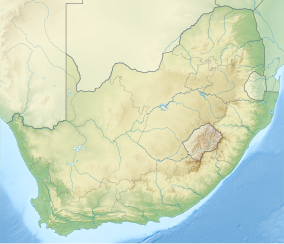West Coast National Park
| West Coast National Park | |
|---|---|
|
IUCN category II (national park)
|
|

Granite formations overlooking the Langebaan Lagoon
|
|
| Location | Western Cape, South Africa |
| Nearest city | Langebaan |
| Coordinates | 33°7′15″S 18°4′0″E / 33.12083°S 18.06667°ECoordinates: 33°7′15″S 18°4′0″E / 33.12083°S 18.06667°E |
| Area | 27,500 hectares (106 sq mi) |
| Established | 1985 |
| Governing body | South African National Parks |
| www |
|
The West Coast National Park lies 120 km (75 mi) north of Cape Town in the Western Cape province of South Africa. It is 27,500 hectares (106 sq mi) in size. It is bordered by the Atlantic Ocean on the west and the R27 coastal road, and runs from the town of Yzerfontein in the south up to the Langebaan Lagoon. The park was proclaimed in 1985. The park is particularly well known for its bird life and for the spring flowers which occur in the months from August to September, especially in the Postberg flower reserve section of the park. The park, with the islands in Saldanha Bay, has been identified by BirdLife International as an Important Bird Area.
Wildlife in the park includes large antelope such as eland, red hartebeest, bontebok, kudu, gemsbok, steenbok, mountain zebra, duiker and ostriches in the Postberg section. Other smaller animals include the bat-eared fox, caracal, and Cape gray mongoose.
Many Palearctic migrants winter in the lagoon during the austral summer, particularly in September as species arrive from the northern hemisphere, and in March when they gather in large numbers to feed up prior to undertaking the return migration. At these times the birds will be transitioning out of and into their breeding plumage. The birds are pushed towards the hides as the water level rises with the tide and eventually they must fly off until the tide has receded once more. Red knot, sanderling, little stint, Ruff, marsh, Terek and Curlew sandpipers, ruddy turnstone, ringed and grey plover, greenshank, Eurasian whimbrel, Eurasian curlew and bar-tailed godwit are the most regular species. Little egret and South African shelduck are resident and can often be seen with the waders, while greater flamingoes and great white pelican occur in deeper water. An isolated hide west of the Geelbek educational centre overlooks a salt pan where it is possible to observe the rare chestnut-banded plover. The lagoon's importance for migratory birds means that it is a site which is subject to the Ramsar Convention for the conservation and sustainable use of wetlands.
...
Wikipedia

